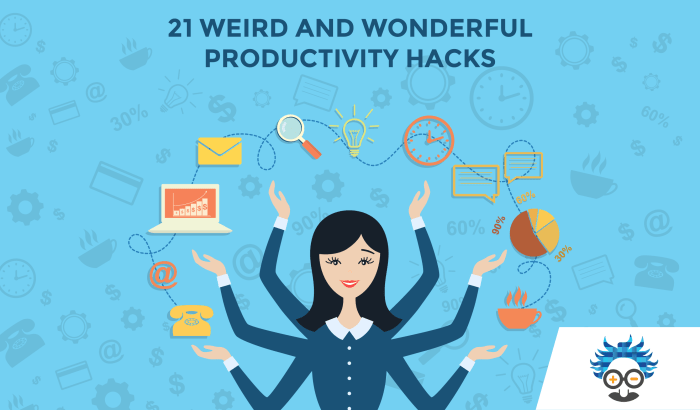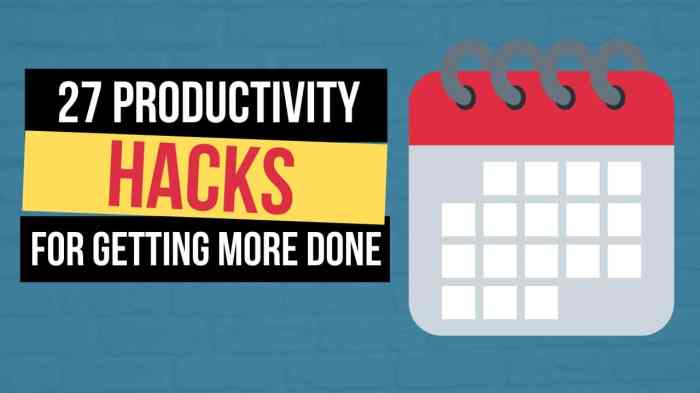Personal Productivity Hacks take the spotlight, inviting you into a world of enhanced efficiency and accomplishment. Get ready to dive into a realm where productivity reigns supreme and success is the ultimate goal.
In this guide, we’ll explore various strategies and techniques to supercharge your productivity and turn your goals into reality. From time management to task prioritization, get ready to unlock your full potential.
Definition of Personal Productivity Hacks
Personal productivity hacks are strategies, techniques, or methods that individuals use to improve their efficiency and effectiveness in completing tasks and achieving goals. These hacks are tailored to suit an individual’s unique preferences, habits, and work style, making them different from general productivity tips that are more generic and may not be as personalized.
Examples of Common Personal Productivity Hacks
- Time blocking: Setting aside specific blocks of time for different tasks or activities to focus and avoid multitasking.
- Pomodoro Technique: Breaking work into intervals with short breaks in between to maintain focus and productivity.
- Creating a to-do list: Prioritizing tasks and setting clear goals for the day to stay organized and on track.
- Using productivity apps: Leveraging technology to track progress, set reminders, and manage tasks efficiently.
Benefits of Incorporating Personal Productivity Hacks
- Increased efficiency: By implementing productivity hacks, individuals can streamline their workflow and accomplish more in less time.
- Improved focus: Personal productivity hacks help minimize distractions and enhance concentration on essential tasks.
- Reduced stress: By better managing time and tasks, individuals can experience less overwhelm and anxiety, leading to a more balanced work-life routine.
- Enhanced goal achievement: Personal productivity hacks enable individuals to set and achieve meaningful goals effectively, boosting their overall success and satisfaction.
Time Management Techniques

Effective time management is crucial for personal productivity. By utilizing different techniques, individuals can maximize their efficiency and accomplish more in less time.
Pomodoro Technique
- The Pomodoro Technique involves breaking work into intervals, traditionally 25 minutes long, separated by short breaks.
- By focusing on a single task during each interval, individuals can maintain high levels of concentration and productivity.
- After completing four intervals, a longer break is taken to rest and recharge before starting the process again.
Eat That Frog Method
- The Eat That Frog method, coined by Brian Tracy, emphasizes tackling the most challenging or important task first thing in the morning.
- By addressing the most daunting task early on, individuals can set a positive tone for the day and prevent procrastination.
- This technique helps individuals prioritize effectively and avoid feeling overwhelmed by their workload.
Real-Life Examples
- By implementing the Pomodoro Technique, a student can focus on studying for 25-minute intervals and take short breaks in between to stay refreshed and alert.
- Using the Eat That Frog method, a professional can start their workday by completing a crucial project that requires their full attention, setting the tone for a productive day ahead.
- Effective time management techniques like these can lead to increased productivity, reduced stress, and a greater sense of accomplishment.
Task Prioritization Strategies
When it comes to personal productivity, one of the key elements is effective task prioritization. By organizing and prioritizing tasks based on their urgency and importance, individuals can maximize their efficiency and accomplish more in less time.
The Eisenhower Matrix
The Eisenhower Matrix, also known as the Urgent-Important Matrix, is a powerful tool for task prioritization. It categorizes tasks into four quadrants based on their urgency and importance:
- Urgent and Important: Tasks that require immediate attention and are crucial to your goals. These should be dealt with first and foremost.
- Important but Not Urgent: Tasks that contribute to your long-term goals and success. Schedule time to work on these tasks to prevent them from becoming urgent in the future.
- Urgent but Not Important: Tasks that demand immediate action but do not align with your long-term objectives. Delegate or eliminate these tasks if possible.
- Not Urgent and Not Important: Tasks that are neither urgent nor important. These tasks can be eliminated or postponed without affecting your productivity.
Using the Eisenhower Matrix can help individuals make better decisions about task prioritization by providing a clear framework for determining which tasks to focus on first.
Impact of Prioritizing Tasks
Prioritizing tasks effectively can have a significant impact on overall personal productivity. By focusing on high-priority tasks that align with your goals and objectives, you can accomplish more in less time and reduce stress. Additionally, prioritizing tasks helps individuals avoid wasting time on low-value activities and ensures that their efforts are directed towards tasks that truly matter.
Goal Setting and Achievement

Setting goals is crucial for improving personal productivity as it provides a clear direction and motivation to work towards. One effective way to set goals is by using the SMART criteria, which stands for Specific, Measurable, Achievable, Relevant, and Time-bound. This method ensures that goals are well-defined and attainable, increasing the likelihood of success.
Step-by-Step Guide to Setting Achievable Goals
Setting achievable goals involves a systematic approach to ensure clarity and focus. Follow these steps to set and track your goals effectively:
- Define your objective: Clearly state what you want to achieve in specific terms.
- Set measurable targets: Establish criteria to track your progress and determine when the goal is accomplished.
- Ensure achievability: Make sure the goal is realistic and within your reach considering your skills and resources.
- Relevance check: Ensure that the goal aligns with your overall objectives and is meaningful to you.
- Set a timeline: Assign a deadline to your goal to create a sense of urgency and focus.
- Track progress: Monitor your advancements regularly, adjusting strategies if needed to stay on course.
Success Stories of Increased Productivity through Goal Setting, Personal Productivity Hacks
Many individuals have experienced significant productivity improvements through effective goal setting. Here are some success stories to inspire you:
- John, a freelance writer, doubled his output by setting daily word count goals and tracking his progress.
- Sarah, a student, improved her grades by setting SMART study goals and regularly reviewing her performance.
- Mike, a project manager, successfully completed a major project ahead of schedule by setting clear milestones and deadlines.